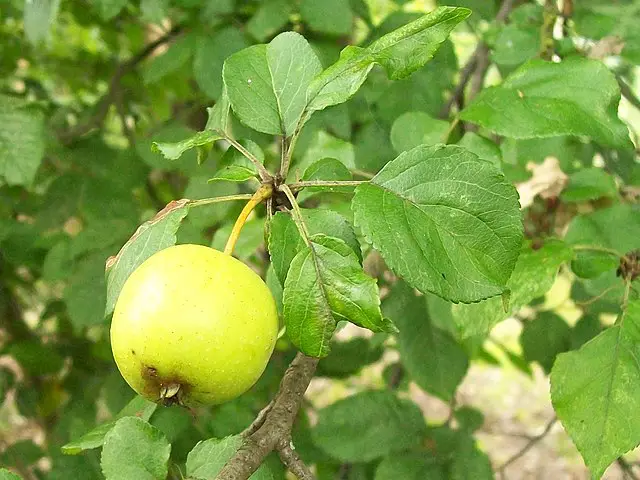Malus Sylvestris crab apple trees are native throughout the British Isles and the literal translation is “forest apple”. This crab apple variety is easily recognisable by its gnarled twigs and often thorny appearance. The white blossom puts on a lovely show during the spring months, followed by small fruits later in the year.

The flowers on Sylvestris crab apple trees make fantastic sources of pollination for a range of insects. The small yellow-green apples are only roughly 2-3 cm in diameter but crab apple trees can produce an abundance of them once they have become established.
They do well in UK gardens due to their hardy nature, and the fact they can pollinate other cultivated apples makes them very advantageous.
Jump To...
Growing & Care of Malus Sylvestris
The leaves on the Sylvestris crab apple tree can be described as mostly oval and the tree is one of the smaller varieties.
Small clusters of blossom form during the spring which are typically white with hints of pink. Crab apples can vary somewhat in appearance but Sylvestris ones are normally yellow-green and small.
Growing to a maximum height of 10m, this wild apple tree has a rounded shape and can spread between 5-10 metres.
They are fairly easy to grow and need little care which makes them perfect for the garden. As long as the positioning is correct, and the tree is checked regularly for signs of damage, yours should grow well and produce great results.
During the Autumn, and often extending well into Winter, you can enjoy picking and eating the crab apples.
As with all crab apple varieties, the Sylvestris variety can be used in a broad range of culinary dishes. This deciduous tree is a great food source for many different animal, bird, and insect species. The tree will reach its maximum height somewhere between 20 and 50 years.
Key Features
- Best Feature: Native to the UK
- When To Plant Out: November to March
- Harvest Fruit: Autumn and Winter
- Best Growing Position: Full Sun & Part Shade
- Soil Type: Chalk, clay, loam or sand
Common Malus Sylvestris Problems
Even the hardiest of fruit trees can be susceptible to common garden pests, they very rarely cause serious issues though.
Wooly Aphids
One such pest is the woolly aphid which can be problematic on both edible and ornamental apple trees.
You may also hear this pest referred to as “American Blight” and they can cause the bark to swell and you may see white fluff on the trunk and branches.
As bizarre as it may sound, brushing your tree with a stiff brush can help with this problem. This, however, will only be successful should you be able to reach the entire tree.
Fireblight
Fireblight is another potential issue faced by varieties of apple trees and pear trees. The name is derived from the appearance that the tree takes – it literally will look like it has been burnt.
This is a bacteria that can cause blossom wilt and cankers to form. Signs of fireblight will be most visible from Spring through until Autumn. The only real treatment for fireblight is to prune out and burn any infected wood.
History of Malus Sylvestris
Like all crab apple varieties, Malus Sylvestris are rich in mythology and have a somewhat romantic past.
Legend has it that people once threw the crab apple pips into the fire to determine if love was true. Should the pips not explode in the fire, then the love wasn’t to be. There is also mention of crab apples in Shakespeare’s plays.
The Sylvestris variety is native to Europe and is said to be one of the main contributors to the domesticated apple. The name translates into “forest apple” and it’s one of the most popular varieties.
Eating Malus Sylvestris
Malus Sylvertris are completely edible but will be better appreciated in cooked dishes due to the tart flavours.
The apples can be a little tough but due to being full of pectin make the perfect crab apple jelly. It can also be worth collecting some of the leaves as they make wonderful tea. Crab apples also make a nice cheese and the bark can be used to make dye.
FAQs
You absolutely can eat Malus Sylvestris – however, you will be hard pushed not to make quite a face while doing so. They are not sweet like other apple varieties, instead, they are a much-valued cooking ingredient for a range of dishes.
You can expect your Malus Sylvestris to grow at a rate of approximately 20-40 cm a year. It can take up to 50 years for the tree to reach its maximum height. It is considered to have an average growth rate.

